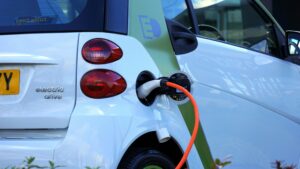
The energy transition in the transport sector represents one of the most complex and urgent challenges of our time. With the sector accounting for around 24% of global energy-related CO₂ emissions, the shift to cleaner mobility systems has become a strategic priority for governments, businesses, and civil society. This article offers a comprehensive and detailed analysis of the two main technologies in contention – electric vehicles (EVs) and internal combustion engine vehicles (ICVs) – thoroughly examining their environmental, social and governance (ESG) impacts, as well as their implications for sustainable development.
The debate between these technologies goes far beyond the simple comparison of energy efficiency or performance. It involves considerations of global supply chains, industrial policies, social justice, public health, and the reconfiguration of urban space itself. To fully understand this transition, it is essential to adopt a systems perspective that considers the entire life cycle of vehicles, from the extraction of raw materials to the end of life, including aspects of infrastructure, consumer behavior and business models.
The Global Context of Automotive Mobility

The global automotive market is at a historic inflection point. On the one hand, electric vehicles experience exponential growth, with global sales reaching 10 million units in 2022, accounting for about 14% of the global new vehicle market. This growth is driven by a combination of technological advancements, cost reduction, and ambitious government policies, particularly in China, Europe, and the United States, which together account for more than 90% of global EV sales.
On the other hand, internal combustion vehicles maintain their dominance in many markets, especially in developing countries, where factors such as a more affordable starting price, consolidated infrastructure, and lack of government incentives create significant barriers to the adoption of alternative technologies. The VCI industry also continues to innovate, developing more efficient engines and exploring alternative fuels such as advanced biofuels and synthetic e-fuels in a bid to prolong their relevance in a world increasingly concerned about climate change.
This technological bifurcation creates significant strains on automakers’ strategies, many of which are making heavy investments in electrification while trying to maximize returns on their existing combustion engine assets. Volkswagen, for example, plans to invest €89 billion in electrification and digitalization by 2026, while Toyota maintains a more diversified strategy, continuing to develop improved combustion engines alongside its electric vehicles.
Comparative Environmental Analysis

When we examine the environmental impacts of the two technologies, it is essential to take a full life cycle approach, considering all phases from production to disposal. In the production phase, electric vehicles have a significantly higher carbon footprint, mainly due to lithium-ion batteries. The production of an average EV emits about 30-40% more CO₂ equivalent than a comparable VCI, with the battery accounting for approximately half of these emissions. This difference is mainly due to the process of mining and refining materials such as lithium, cobalt and nickel, which are energy-intensive.
However, this initial disadvantage is compensated for during the use phase. A typical electric vehicle operating on the average European electricity grid emits around 50-60% less CO₂ over its lifetime compared to a similar petrol one. In countries with predominantly renewable electricity matrices, such as Norway or Iceland, this advantage can reach 80-90%. VCIs, on the other hand, continue to emit greenhouse gases and air pollutants locally throughout their lifetime, with little scope for significant additional improvements in their efficiency.
The issue of materials presents another complex environmental dilemma. The production of batteries for EVs requires substantial amounts of metals such as lithium, cobalt and nickel, the extraction of which often involves significant environmental impacts, including intensive water consumption (about 2.2 million liters per ton of lithium in the Salar de Atacama) and ecosystem degradation. In contrast, VCIs rely primarily on oil, the extraction and refining of which also have severe environmental impacts, but in a more mature and regulated supply chain.
Social and Public Health Impacts
The transition to electric vehicles has profound societal implications that go far beyond environmental considerations. In public health, the benefits are clear and measurable. The World Health Organization estimates that outdoor air pollution causes about 4.5 million premature deaths annually, with combustion vehicles being a major contributor. Studies in cities that have massively adopted EVs, such as Oslo in Norway, show 60-70% reductions in NOx and particulate matter concentrations, resulting in significant improvements in the respiratory health of the population.
In the field of employment, the transition creates both opportunities and challenges. The electric vehicle value chain tends to generate jobs in new sectors such as battery production, charging infrastructure, and software development for autonomous vehicles. However, many of these jobs require different skills than those in the traditional automotive industry, creating reskilling challenges. At the same time, jobs in established sectors such as combustion engine component production, fuel station network and traditional maintenance services face significant risk.
Affordability remains a key barrier to widespread adoption of EVs, particularly in emerging markets. While the total cost of ownership (TCO) of EVs is already competitive in many developed markets thanks to lower energy and maintenance costs, the higher upfront price – mainly due to the cost of batteries – remains a significant obstacle for middle- and low-income consumers. Well-designed incentive programs, such as those implemented in Germany and France, which combine purchase subsidies with infrastructure investment, have proven effective in accelerating adoption.
Infrastructure and Technological Challenges

Charging infrastructure represents one of the biggest challenges to mass adoption of electric vehicles. While the global network of charging stations exceeded 1.5 million public points in 2022, it still lags significantly behind the existing infrastructure for combustion vehicles, which has more than 3 million gas stations in the US alone. The geographical distribution is also uneven, with a concentration in urban areas of developed countries, leaving many rural regions and developing countries with limited access.
Battery technology remains the critical limiting factor for EVs. While energy density has improved significantly (increasing by about 5-8% per year) and costs have fallen dramatically (from $1,200/kWh in 2010 to around $132/kWh in 2023), challenges remain regarding charging time, lifespan in extreme climates, and raw material availability. The next generation of solid-state batteries promises significant improvements in safety, energy density, and charging time, but their commercialization at scale still faces technical and production hurdles.
For VCIs, the technological challenges revolve around complying with increasingly stringent environmental regulations without compromising affordability and performance. Emissions aftertreatment systems have become incredibly complex and expensive, while the push for energy efficiency has led to engines with increasingly tight tolerances, potentially impacting long-term reliability and maintenance costs.
Governance and Public Policy Considerations
Government policies are playing a crucial role in shaping this market in transition. The European Union has set some of the most ambitious regulations, including an effective ban on new VCIs from 2035 and strict requirements for charging infrastructure. China, for its part, has adopted a “push and pull” approach, combining generous subsidies for EVs with increasingly severe restrictions on VCIs in its major cities.
In the United States, the Inflation Reduction Act of 2022 represents the most significant incentive package for clean vehicles in the country’s history, offering tax credits of up to $7,500 for EV purchases, with progressively stricter requirements on local content and materials. This approach reflects growing geopolitical concerns about reliance on supply chains concentrated in China.
For developing countries, the challenges are even more complex. Many rely significantly on revenues derived from fossil fuels and face difficult choices between adopting cleaner technologies and protecting domestic industries and jobs. Brazil, with its successful ethanol program, represents an interesting case of how biofuels can offer a transition pathway, albeit with clear limitations in terms of scalability and sustainability.
Future Scenarios and Strategic Considerations

Looking ahead to the next decade, we are likely to see a growing regional divergence in technology trajectories. Developed markets with strong decarbonization policies are likely to see EVs dominate new vehicle sales as early as 2025-2030, while in many emerging markets VCIs may hold significant share for longer, possibly with increasing use of biofuels or synthetic fuels as a technology bridge.
The battery industry is set to undergo profound transformations, with the next generation of technologies (solid-state, sodium-ion) potentially radically altering the economic equation. At the same time, consolidating efficient recycling chains will be critical to mitigate concerns about material availability and environmental impacts.
For automakers, the transition represents an existential challenge, requiring not only technological changes but profound transformations in business models, supply chains, and customer relationships. The rise of mobility-as-a-service (MaaS) models and autonomous vehicles could further accelerate these changes, potentially reducing the overall size of the global fleet while increasing average utilization per vehicle.
Conclusion
The comparison between electric and combustion vehicles in the context of ESG and sustainability reveals a complex picture, with significant trade-offs in several dimensions. While EVs offer clear advantages in terms of reducing operational emissions and local pollution, their environmental impact at the production stage and issues related to the mining of critical materials present real challenges that need to be addressed.
VCIs, on the other hand, benefit from mature infrastructure and lower upfront costs, but face fundamental limits on their ability to contribute to ambitious climate goals. Alternative fuels may prolong their relevance in certain niches, but they are unlikely to represent a comprehensive solution.
In the long term, the trajectory toward electrification seems inevitable, but its exact pace and shape will depend on continued technological advances, effective public policies, and innovative approaches to addressing social and supply chain challenges. The most promising path may not be a complete replacement, but a strategic transition that leverages the strengths of each technology while mitigating its negative impacts.

Sem comentários